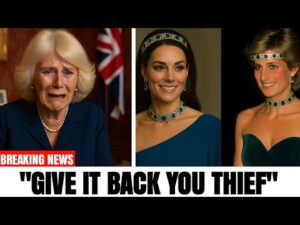Royal Cover-Up EXPOSED: The Real Cause of the Queen’s Death SHOCKS the World

It was a moment the world thought it was prepared for. A moment anticipated with solemn reverence for years, whispered about in newsrooms, rehearsed in royal protocols, woven into history books, yet unwritten. But when the day arrived, nothing could have truly braced the globe for the heartbreak and uncertainty that followed. Queen Elizabeth II, Britain’s longest-reigning monarch, a figure who seemed as eternal as the stone walls of Windsor, had passed away.
The news flashed across screens in a haze of solemn commentary and black attire. Newscasters spoke softly, almost reverently, as if afraid to fracture the silence left in her absence. Crowds gathered outside Buckingham Palace. Candles flickered against the chilly twilight, and the weight of nearly a century of British history pressed down on every square inch of the kingdom.
Before we continue, please hit the like button, subscribe to the channel, and turn on the notification bell for updates. For most of the world, the story seemed straightforward, even gentle in its finality. The palace issued a brief statement: Her Majesty died peacefully at Balmoral with family at her side. The official cause was listed simply as old age. It was a phrase that felt both honest and profoundly evasive, as if trying to draw a curtain over a scene the public wasn’t meant to see.
But there’s something about the word peacefully. It suggests calm, serenity, order. And in the world of monarchies, especially the House of Windsor, there is a long tradition of ensuring that no matter the chaos behind palace doors, the outward image remains impeccable, clean, controlled. Yet, behind the solemn ceremonies and perfectly choreographed rituals, rumors were already gathering like storm clouds. Journalists who had covered the royal family for decades whispered about discrepancies in timelines.
Sources inside the palace described a tense atmosphere as if something deeply unsettling was unfolding away from public view. Then came the leak—a leak so explosive it threatened to rip open the fabric of royal secrecy. A royal insider cloaked in anonymity stepped forward with a claim that chilled every nerve in the newsroom. According to this insider, the queen’s autopsy, which the public had been assured was purely routine, had allegedly revealed something stunning.
Traces of a substance had been detected in the queen’s system—a medication, but not one listed in any of her official medical records. And with that revelation, everything changed. Because in the royal world, secrets are currency, and health secrets above all are guarded like state treasures. For a monarch whose entire life was built on duty, stability, and public confidence, even the slightest hint of hidden ailments or unauthorized treatments could spiral into scandal.
And now the whispers suggested something even darker. Was this merely a medical oversight? Or was the queen unknowingly medicated? Or worse, did someone tamper with her treatment? The leak lit a match under the public’s imagination. Suddenly, the question wasn’t merely how the queen died, but whether her death had truly been as peaceful, as natural as the official statements claimed. The story began to stretch its tendrils into every corner of British life—the monarchy, the government, the press, the people. It hinted at the possibility of a cover-up, or at the very least, a medical mystery hidden from the world.
It’s easy to look back on the day of the queen’s passing as an ocean of grief—a nation draped in black, flags at half-mast, solemn bell tolls echoing through ancient cathedrals. But grief has layers. Underneath the sorrow, there was confusion. Underneath confusion, there was suspicion. And under suspicion, there was fear—a quiet terror that maybe, just maybe, the monarch who stood as Britain’s steadfast anchor had been swept away under circumstances no one dared speak aloud.
Let me ask you this: what would you do if you discovered that the single most trusted figure in your nation might have been living and dying under the influence of substances never meant to be there? Would you demand the truth even if it shattered your image of the monarchy? Or would you turn away, preferring the comfort of the official narrative? These are not just questions for historians or journalists. They are questions for every citizen who ever believed in the mystique of the crown.
Because this story is not merely about the queen’s death. It’s about how history is written and how much of it is concealed. And here’s where the story becomes even more tangled. Over the years, the British royal family has been no stranger to secrets. From King George VI’s concealed cancer diagnosis to the dark swirl of conspiracy.




